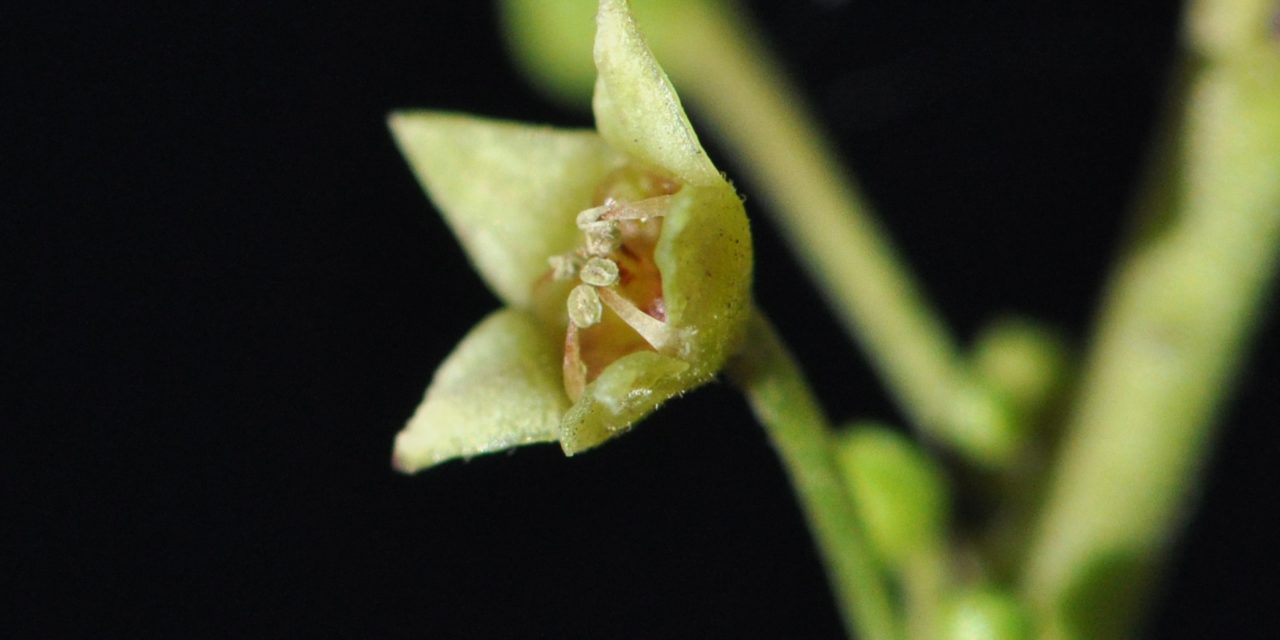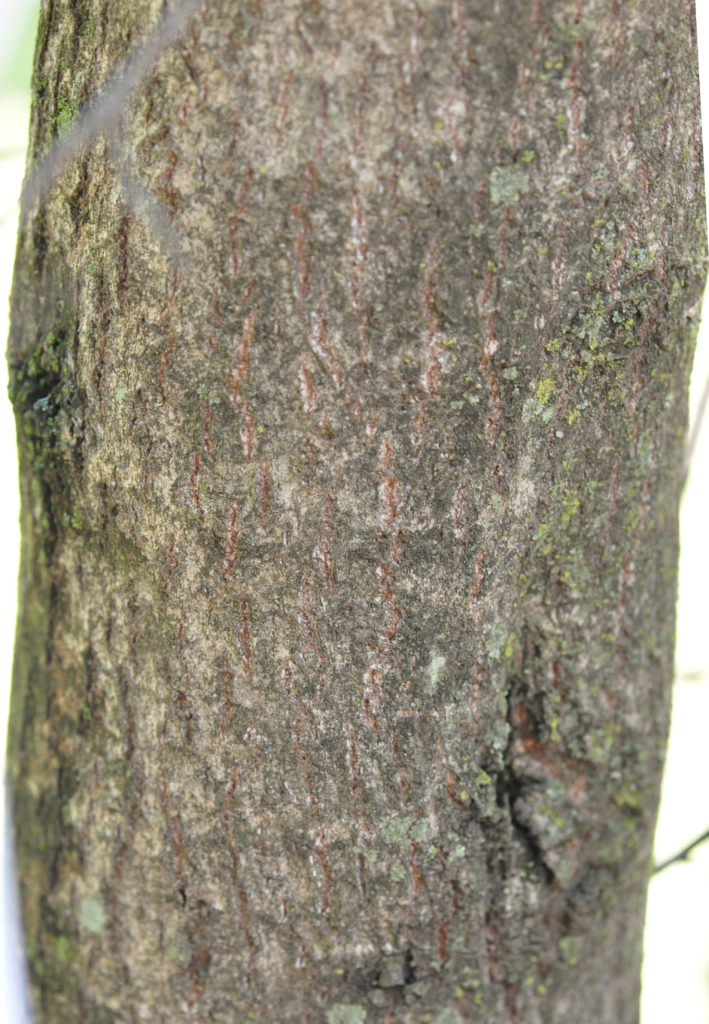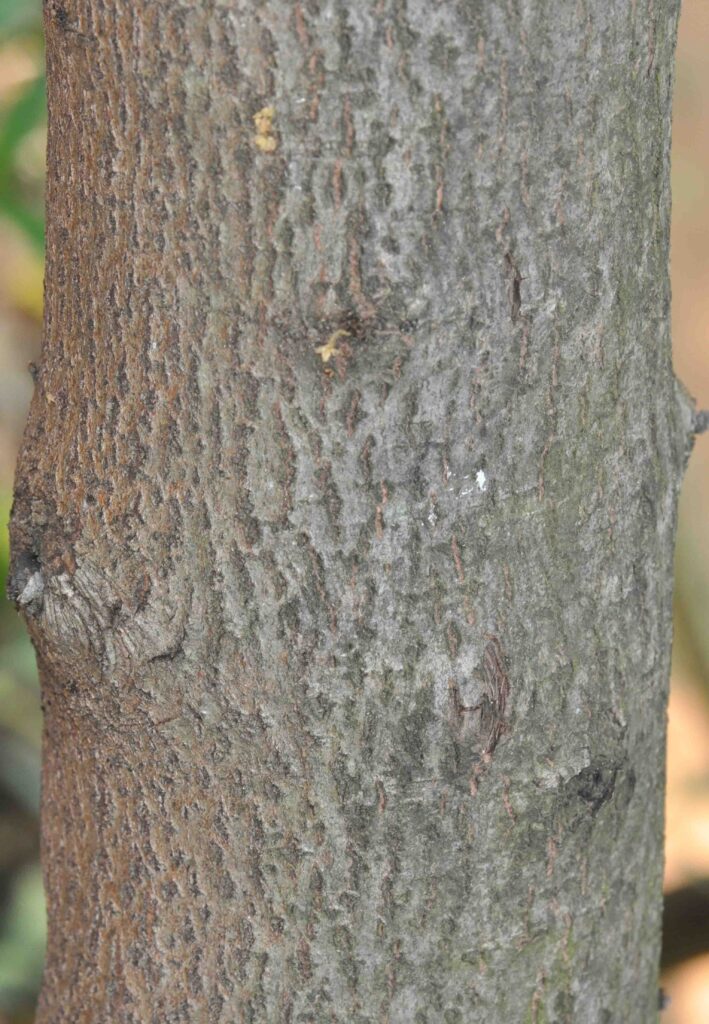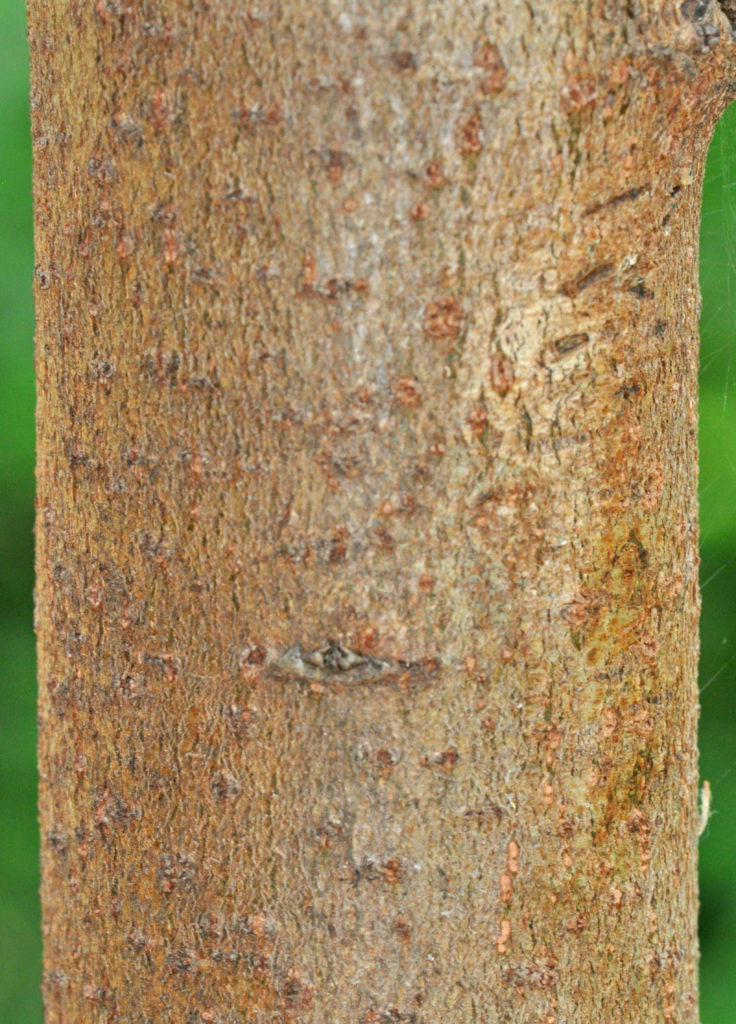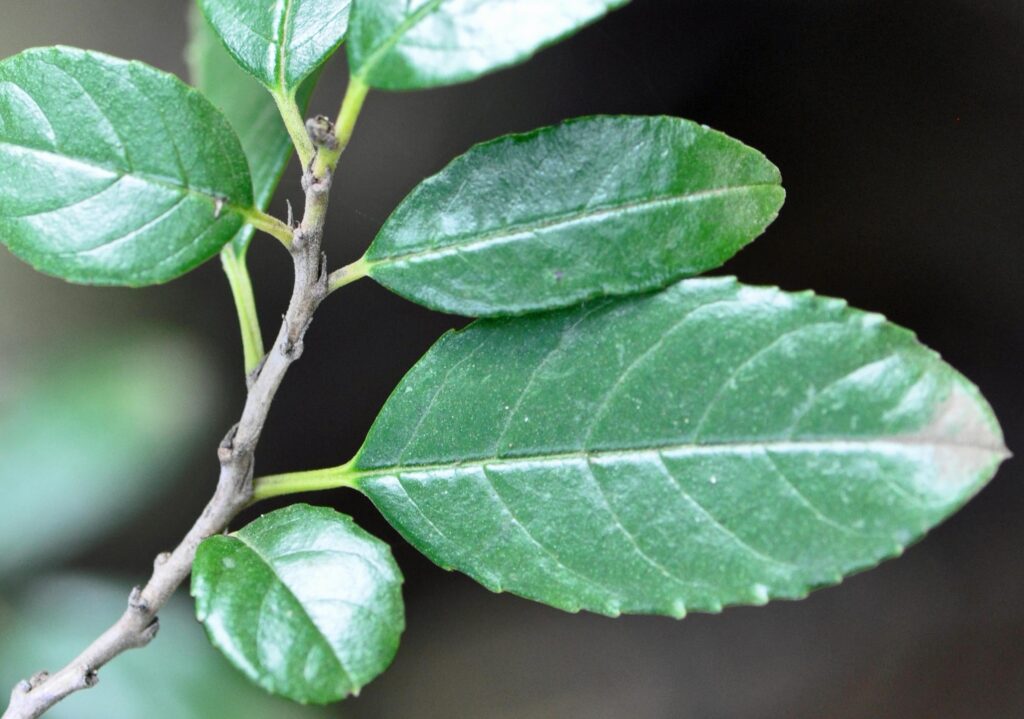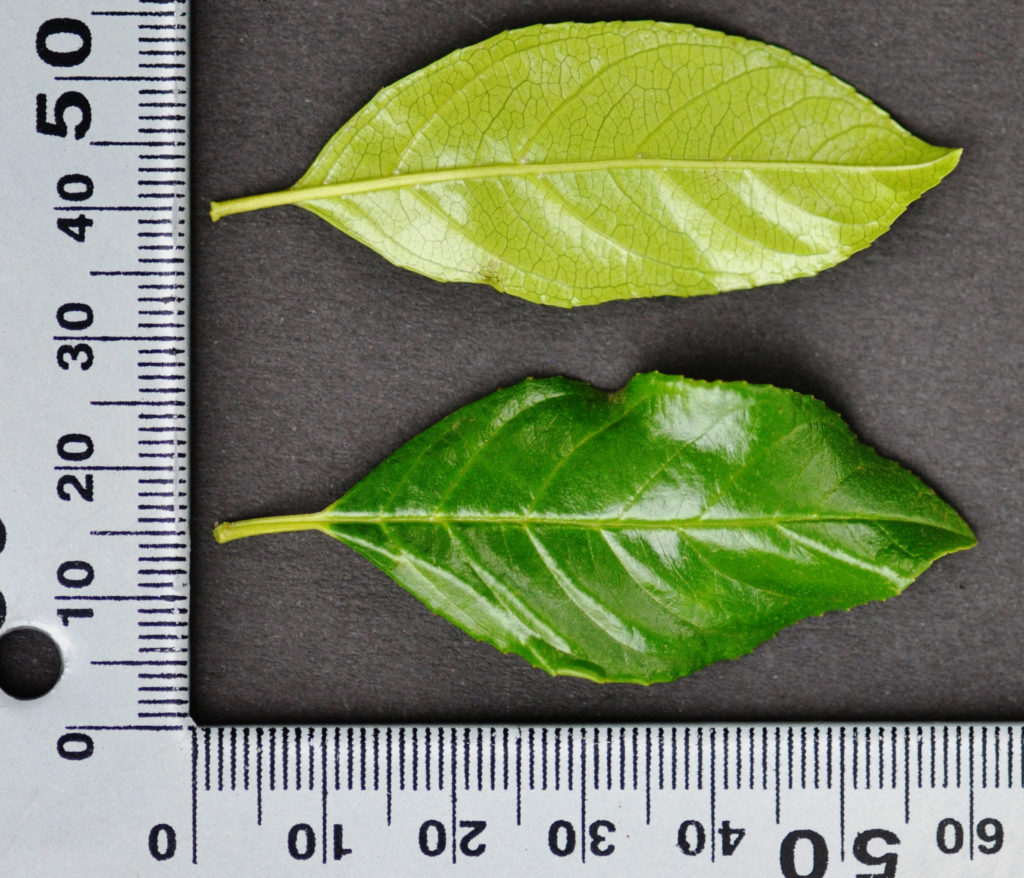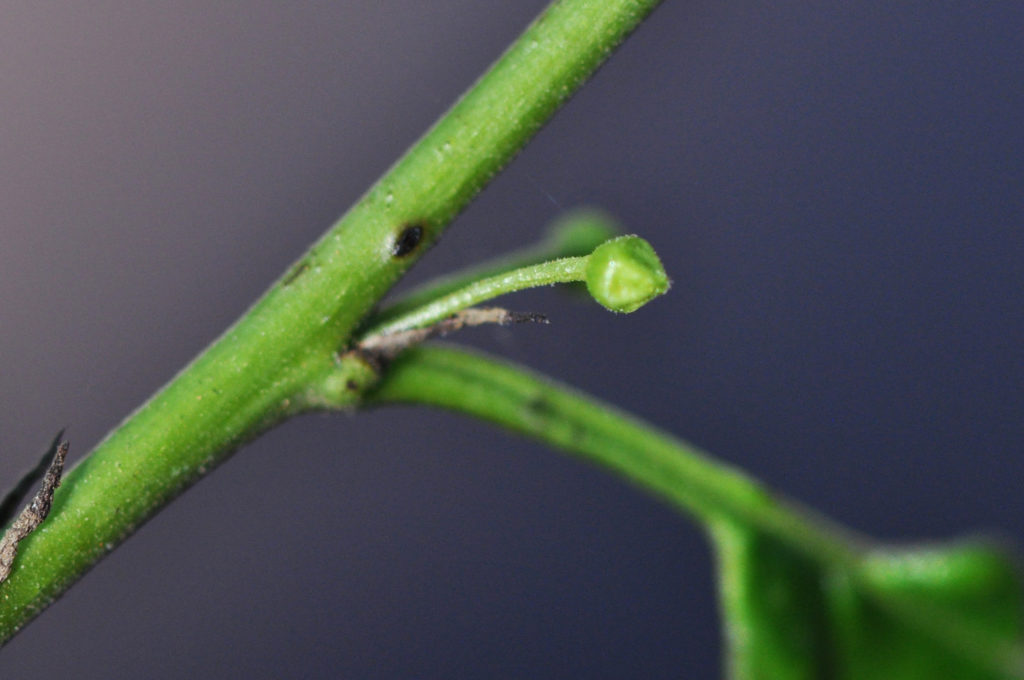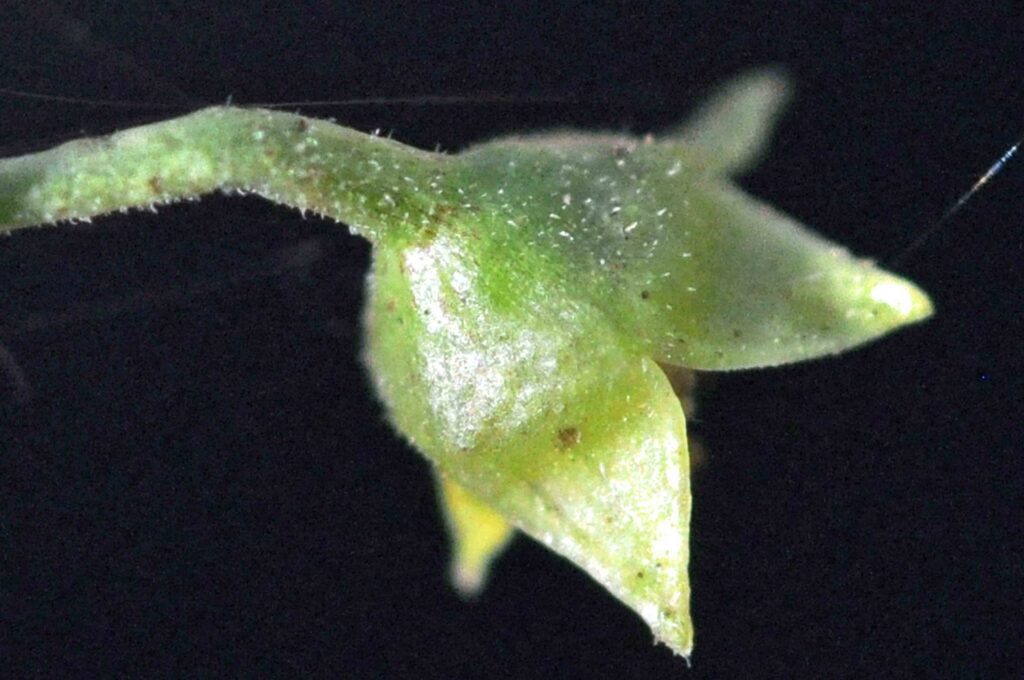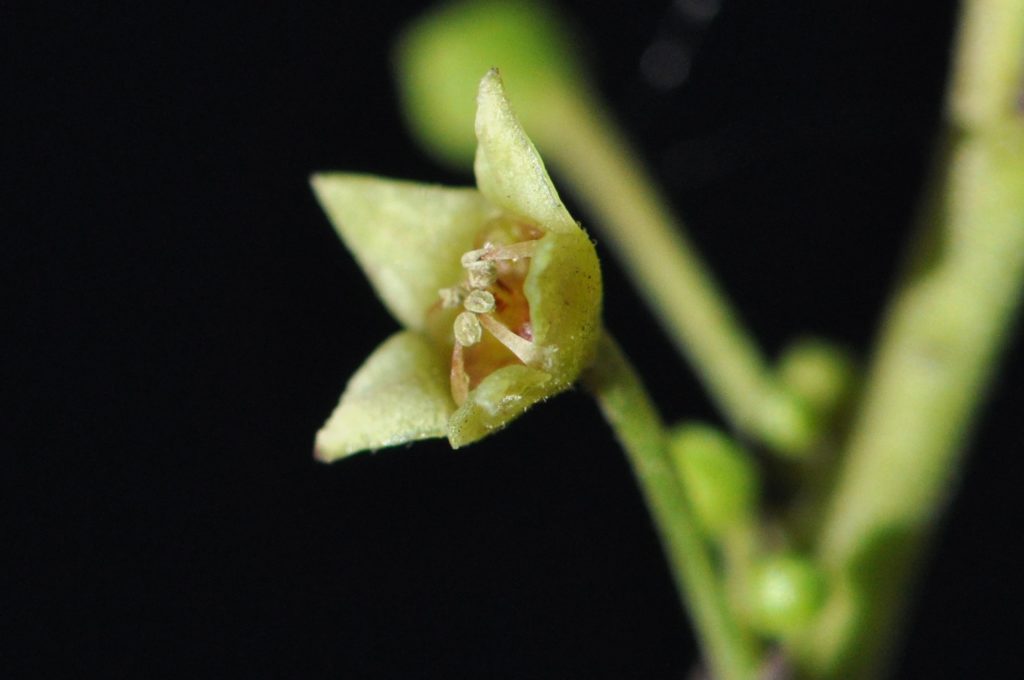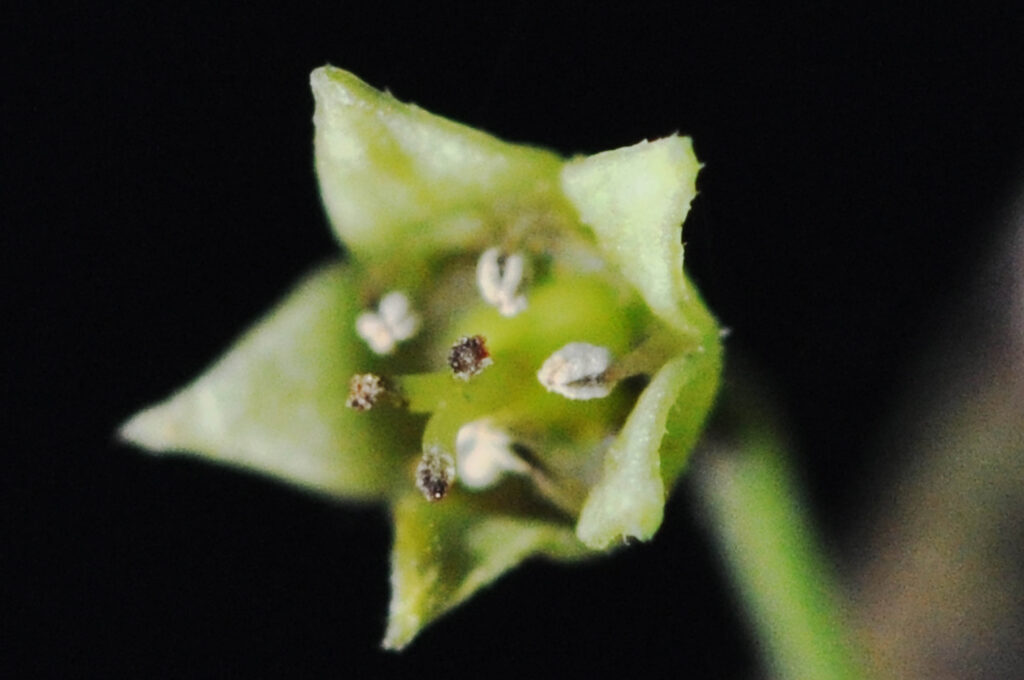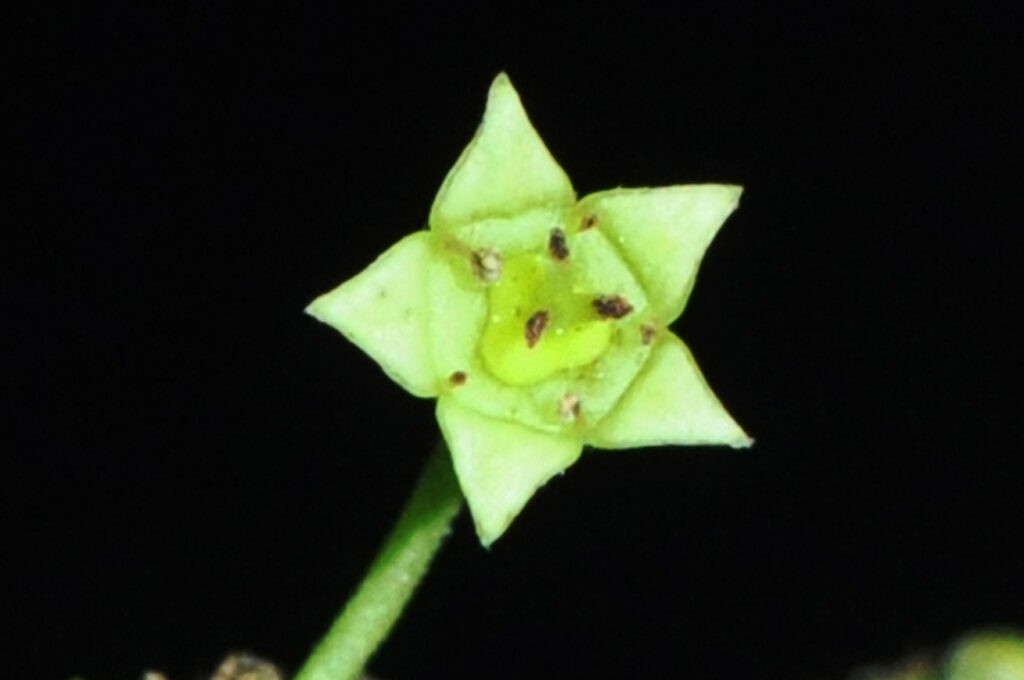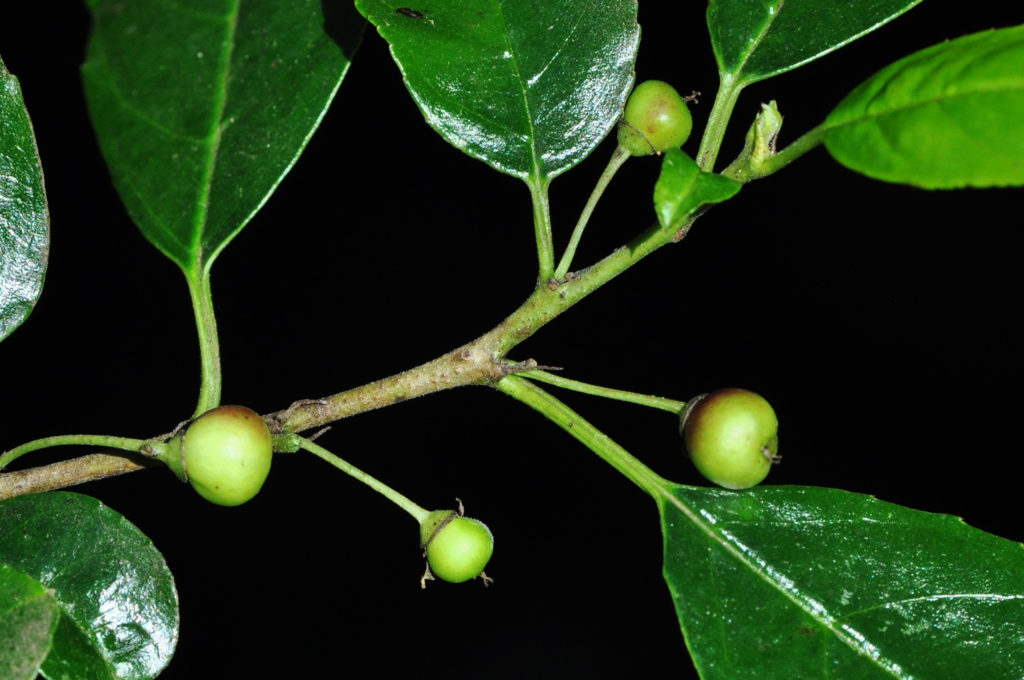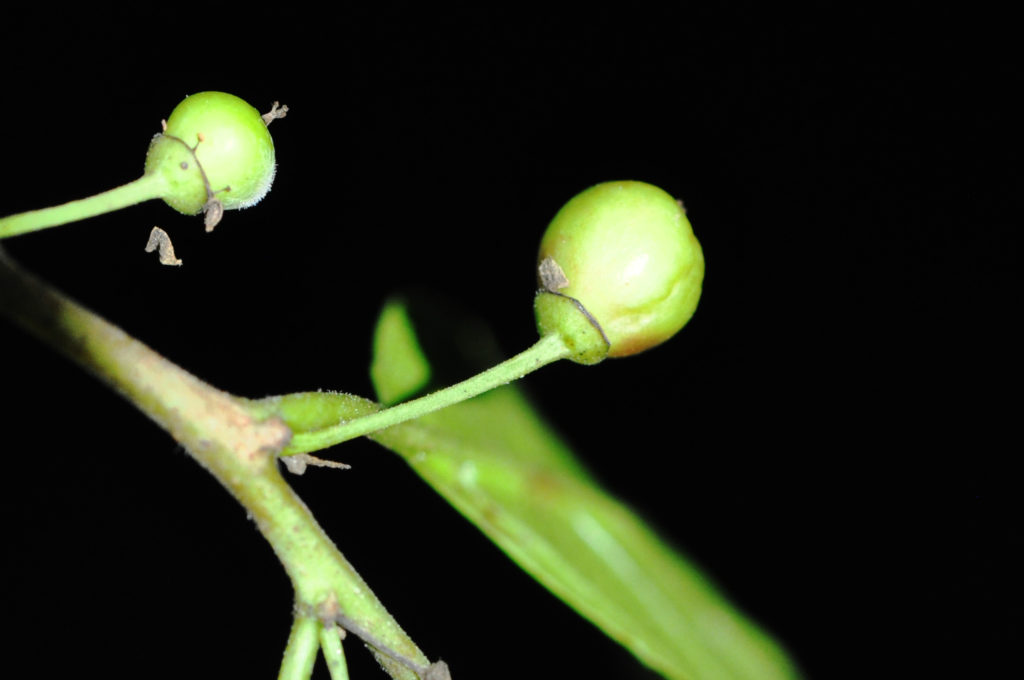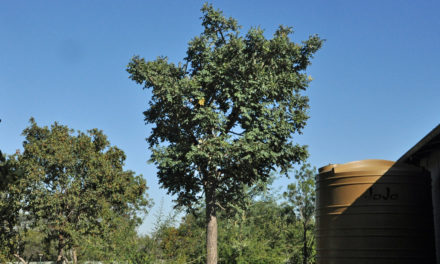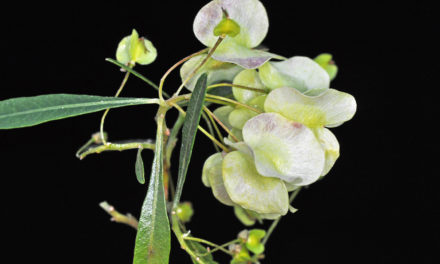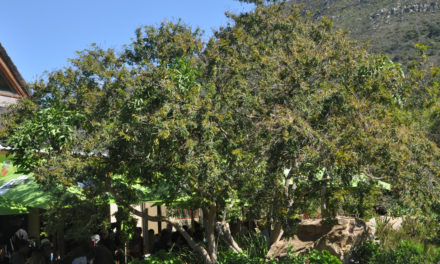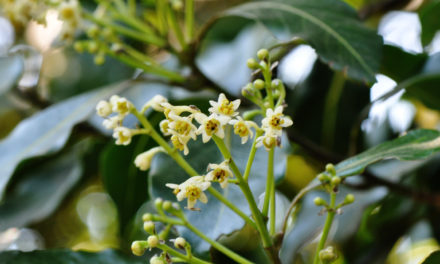General Info – summary
This evergreen spineless Tree may reach 7m high but is often bushy. Simple, shiny Leaves are hairless, and the margin may be finely toothed. Yellowish green actinomorphic and bisexual Flowers arise on a pedicel and are tiny and 5-merous with reduced petals. 3 persistent styles are present. The small pea sized Fruit is an edible drupe + a persistent cup-shaped calyx & matures to a red and finally to a purple or black.
Description
Rhamnus prinoides
Previous Names: Celtis rhamnifolia Rhamnus celtifolius, Rhamnus pauciflorus.
SA Tree No. 452.
Common names: (Afr) Blinkblaar, Blinkblaarboom, Camdeboostinkhout, Hondepis, Hondepisboom, Hondepishout, Kamdeboo-stinkhout, Perdebessie, Perdepisbessies, Rooibos, Seerkeelboom. (Eng) Camdeboostinkwood, Camdeboo Stinkwood, Dogwood, Glossy-leaf, Redwood, Shiny-leaf. (isiZulu) Umglindi, Umhlmye, Umyenye, Unyenya, Unyenye. (Northern Sotho) Mofifi. (siSwati) Inyenye. (isiXhosa) Ulatile, Ulunyenye, Umamfobe, Umglindi, Umlindi, Umnyenye.
Family: Rhamnaceae. (Buckthorn Family). This family mainly contains trees and shrubs. It has about 58 genera and 900 species. In South Africa, there are 9 genera and 203 species. Trees on this website include Berchemia, Noltea, Rhamnus and Ziziphus. Leaves are simple and usually alternate, and stipules are present – if only for a short time. Flowers are actinomorphic (regular and symmetric) and a prominent hypanthium (the cup-like receptacle usually derived from the fusion of floral envelopes and androecium, and on which are seemly borne calyx, corolla and stamens) is present. Sepals are well developed, and Petals are free and in 4’s or 5’s. The Calyx is tubular, and sepals do not overlap. The free petals arise from the calyx tube or from the outer margin of the disc. The 4-5 Stamens arise with, and opposite to the petals. Anthers have up to 2 pollen sacs and pollen is released through longitudinal slits. The Ovary is usually superior and has 2-5 chambers. Fruit is a drupe, which is partly enclosed by a persistent Calyx. Most members have adapted to dry climates.
Name derivation: Rhamnus – Greek – signifying “a tuft of branches”. prinoides resembles Prinos an evergreen oak with its shiny leaves. This is the only species of the genus Rhamus in southern Africa. Worldwide there are about 125 species.
Conservation: National Status: L C (Least Concern). Assessed: 2005 (W. Foden and L. Potter).
Tree
This spineless Tree may reach 6m high – usually less, or it can be a bushy, sometimes scrambling shrub. The Trunk (or trunks) lack a basal buttress and has a diameter up to about 20cm. The Bark is brown to grey (Photo 533 -532) and smooth (photo 533). It becomes dark brown and glabrous (hairless) with age. Young branches often develop low down, are pale brown and pubescent (with dense fine, short, soft hairs, downy). They develop conspicuous Lenticels (a usually raised corky oval or elongated area on the plant that allows the uncontrolled interchange of gases with the environment – photo 532 & 533).
- 269 2014.10.21 Walter Sisulu NBG. Photo: David Becking.
- 532 2016.09.27 Walter Sisulu NBG. Photo: David Becking.
- 533 2016.09.27 Walter Sisulu NBG. Photo: David Becking.
Leaves
This evergreen plant has Leaves that are alternate (occasionally nearly opposite) or spirally arranged and simple (have a single blade which may have incisions that are not deep enough to divide the blade into leaflets). Mature leaves are relatively flat, and shape varies from ovate to elliptic to oblong-elliptic. They are up to 10 x 4cm (usually smaller). Big and small leaves may be visible at the same time (photo 781). The Blade of the leaf has sunken side Veins above and these protrude and are clearer below (photo 518). The side veins curve slightly towards the apex. Leaves are bright glossy dark green above and mature leaves may glitter in sunlight – like the olive (Olea europaea subsp. africana), Silver Cluster-leaf (Terminalia sericea), buffalo-thorn (Ziziphus mucronate – also in the family Rhamnaceae) and Stamvrug (Englerophytum magalismontanum). The lower surface less shiny and a duller green. The Midrib is indented above (photo 781) and protrudes below. Leaves may curl backwards. Hairy pockets with domatia (hair-tuft domatia: a tiny chamber produced by plants that house arthropods. To the naked eye the domatia appear as small bumps) may be present in axils of main lateral veins – otherwise the leaves are hairless. Young leaves are light green and mature leaves may glitter in sunlight (photo 781) – like the olive (Olea europaea subsp. africana), Silver Cluster-leaf (Terminalia sericea), buffalo-thorn (Ziziphus mucronate – also in the family Rhamnaceae) and Stamvrug (Englerophytum magalismontanum). Apart from the glitter, the leaves in these plants are quite different. In Rhamnus prinoides the Apex is sharply to bluntly pointed (photo 781). The Base is wedge-shaped to round. The slightly rolled under Margin (photos 781 & 581) is scalloped to finely serrate – more so away from the base. The Petiole (leaf stalk) varies from short to 1,5cm long and is grooved above (photo 518). The Stipules (basal appendages of the petiole) are small and may fall early (photo 781). Temperature drop or water shortage may induce this loss.
- 781 2016.05.10 Walter Sisulu NBG. Photo: David Becking.
- 518 2014.10.28 Walter Sisulu NBG. Photo: David Becking.
Flowers
The yellowish green, pentamerous (parts in 5’s) and bisexual Flowers are actinomorphic (Regular, symmetrical. Flowers are vertically divisible into similar halves by more than 1 plane passing through the axis). They are tiny – to about 3mm wide and rest on slender hairy Pedicels (stalk of a single flower – photo 785) that is up to 1cm long (photo 789). Flowers are located in clusters of up to 10 in leaf axils. Flowers are perigynous (borne on a ring or cup of the receptacle surrounding a pistil). The Calyx has 5 outwardly hairy, spreading Sepals (photo 785) which are greenish and keeled on the inner face. The Disc (a more or less fleshy or elevated development of the receptacle) is inconspicuous and lines the calyx tube. Petals are diminished. The 5 Stamens are shorter than the calyx lobes and situated between the sepal lobes (photo 146). Anthers release their pollen through longitudinal slits. There is a single Pistil (a unit of the Gynoecium, the female element of the flower, composed of the Ovary, Style and Stigma). Here the superior Ovary is 2-4 locular and there are 3 Styles present (photo 788). (Oct-May++).
- 789 2017.11.07 Walter Sisulu NBG. Photo: David Becking.
- 785 2017.11.07 Walter Sisulu NBG. Photo: David Becking.
- 146 2019.10.03 Walter Sisulu NBG. Photo: David Becking.
- 788 2017.11.07 Walter Sisulu NBG. Photo: David Becking.
Fruit
The edible pea-sized Fruit is a Drupe (a fleshy, 1-seeded indehiscent fruit with the seed enclosed in a stony endocarp; stone fruit e.g., peach). In photo 813 of a young green fruit, the remains of the 3 persistent styles are visible. Later in the fruit development (photo 819), the remains of the styles at the apex of the fruit can still be seen. Remains of both the cup-like calyx and the stamens are visible in photo 820. The mature fruit is red to purplish black, ovoid to almost spherical, and usually divided into 3 compartments. Each fruit is about 6mm in diameter and rests on a long slender Pedicle (stalk of a single flower – photo 819). The maturing fruit changes from green to shiny red and finally to purple or black. (Nov-Jun).
- 813 2016.11.29 Walter Sisulu NBG. Photo: David Becking.
- 819 2016.11.29 Walter Sisulu NBG. Photo: David Becking.
- 820 2016.11.29 Walter Sisulu NBG. Photo: David Becking.
Distribution & Ecology
These Plants are found in forest margins, riverbanks, margins of evergreen forests and grassland from sea level to 2 200m. They are reasonably frost resistant and more common at the higher altitudes where they survive in low temperatures. The tree provides a deep shade thus limiting other growth below it. The tree survives in both direct sunlight and in light shade. They grow in mountains, stream banks, among rocks, and on forest slopes. Bees are attracted to the Flowers and probably contribute to pollination. The Forest-king Charaxes or Forest King Emperor butterfly (Charaxes xiphares) gain larval food from this plant and from others – including Schotia brachypetala. Plants occur from Swellendam in the Western Cape through the Eastern Cape, Free State, KwaZulu-Natal (especially from Estcourt to Giants Castle), Gauteng, Mpumalanga, and Northern Province. They also occur in Lesotho, Swaziland and, Mozambique, Zimbabwe, Angola and northwards to Ethiopia and Eritrea.
Ethnobotany
A drink made from the Leaves, brings in a lot of revenue. Leaves are also the larval food for the Forest King Emperor butterfly (Charaxes xiphares). The edible Fruit attracts many birds. The white to yellow Wood is fairly dense, hard and heavy. Apart from making sticks, the wood is too small to be of much use. It may be useful to plant and protect drainage canals for erosion control. This is a slow growing but attractive tree for the garden. It can be planted as a hedge or wind barrier. It is easily Grown from seeds. The plant is tough, frost resistant and the small tree will do well in most gardens. The fleshy part of the fruit contains a growth inhibitor. Remove the inhibitor before planting the Seeds. Cut leafy branches placed in water last a long time. In places, the tree is used to prevent being struck by lightning. In some places, pegs are driven onto the ground around fields to protect them from harm. Parts of the tree are used as hunting charms.
References
Boon, R. 2010. Pooley’s Trees of eastern South Africa. Flora and Fauna Publications Trust, Durban.
Burrows, J.E., Burrows, S.M., Lotter, M.C. & Schmidt, E. 2018. Trees and Shrubs Mozambique. Publishing Print Matters (Pty) Ltd. Noordhoek, Cape Town.
Coates Palgrave, M. 2002. Keith Coates Palgrave Trees of Southern Africa, edn 3. Struik, Cape Town.
Foden, W. & Potter, L. 2005. Rhamnus prinoides L’Hér. National Assessment: Red List of South African Plants version 2020.1. Accessed on 2023/11/11.
Lawrence, G. H. M, 1951. Taxonomy of Vascular Plants. The Macmillan Company, New York. Tenth Printing 1965.
Palmer, E. & Pitman, N. 1972. Trees of southern Africa. Balkema, Amsterdam, Cape Town.
Schmidt, S. Lotter, M. & McCleland, W. 2002. Trees and Shrubs of Mpumalanga and the Kruger National Park. Jacana, Johannesburg.
van Wyk, B. & van Wyk, P. 1997. Field guide to Trees of Southern Africa. Struik, Cape Town.
http://www.plantzafrica.com/plantqrs/rhamnusprinoid.htm
http://www.zimbabweflora.co.zw/speciesdata/species.php?species_id=137730
http://tropical.theferns.info/viewtropical.php?id=Rhamnus+prinoides
http://www.worldagroforestry.org/treedb2/AFTPDFS/Rhamnus_prinoides.PDF
http://posa.sanbi.org/flora/browse.php?src=SP
https://en.wikipedia.org/wiki/Charaxes_xiphares

